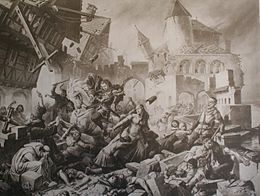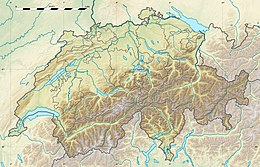1356 Basel earthquake
 Basel earthquake as envisioned by Karl Jauslin | |
| Local date | 18 October 1356 |
|---|---|
| Local time | 22:00 |
| Magnitude | 6.0–7.1 Mw |
| Epicenter | near Basel 47°30′N 7°36′E / 47.5°N 7.6°E |
| Max. intensity | MSK-64 IX (Destructive) – MSK-64 X (Devastating) |
| Casualties | 1,000 |
The 1356 Basel earthquake is the most significant
Earthquake
After a foreshock between 19:00 and 20:00 local time, the main earthquake struck at around 22:00, and numerous aftershocks followed through that night.[4] Basel experienced a second, very violent shock in the middle of the night. The town within the ramparts was destroyed by a fire when torches and candles falling to the floor set the wooden houses ablaze. The number of deaths within the town of Basel is estimated at 300. All major churches and castles within a 30 km (19 mi) radius of Basel were destroyed.[5]
The seismic crisis lasted a year. The modeling of the macroseismic data
Location
Due to the limited records of the event, a variety of epicenters have been proposed for the earthquake. Some of the proposed locations include faults beneath the Jura Mountains or along the Basel-Reinach escarpment.[1] Another study placed the epicenter 10 km (6.2 mi) south of Basel.[9]
Intensity
The earthquake was felt as far away as Zürich, Konstanz, and even in Île-de-France. The maximum intensity registered on the Medvedev–Sponheuer–Karnik scale was IX–X (Destructive–Devastating). The macroseismic map was established on the basis of damage reported by the region's 30 to 40 castles.[5][10]
From this macroseismic data, various studies have been conducted to estimate the moment magnitude of the earthquake, which have resulted in various values of 6.2 (BRGM 1998);[2][5] 6.0 (GEO-TER 2002);[2] 6.9 (SED 2004) with a follow-up report suggesting a range of between 6.7 and 7.1;[2] 6.6 (GFZ 2006);[2] and a major Swiss study by 21 European experts, with American involvement, in which four sub-groups estimated values of 6.9, 6.9, 6.5 to 6.9, and 6.5 ± 0.5 (PEGASOS 2002–2004).[2] There are also different opinions about which faults were involved.[2]
Damage
The
See also
 Switzerland portal
Switzerland portal- List of earthquakes in Switzerland
- Fessenheim Nuclear Power Plant
- Induced seismicity in Basel
- List of historical earthquakes
References
- ^ a b c "1356 Basel Earthquake: A 650-Year Retrospective" (PDF). Risk Management Solutions. 2006. Archived from the original (PDF) on 29 February 2012. Retrieved 7 January 2015.
The most damaging intraplate earthquake known to have occurred in central Europe
- ^ a b c d e f g Centrale Nucléaire de Fessenheim : appréciation du risque sismique Archived July 20, 2011, at the Wayback Machine RÉSONANCE Ingénieurs-Conseils SA, published 2007-09-05, pages 12, 13
- ^ "Das Erdbeben von 1356" (in German). Altbasel.ch. 24 October 2006.
- ^ Von Waltenkofen K. (1357). Alphabetum Narrationum.
- ^
- ^ Meyer, B., Lacassin, R., Brulhet, J., Mouroux, B., 1994. "The Basel 1356 earthquake: which fault produced it?" Terra Nova 6, 54–63.
- S2CID 34852180.
- .
- .
- ^ D. Mayer-Rosa and B. Cadiot (1979). "A review of the 1356 Basel earthquake: basic data", Tectonophysics, 53, pp. 325–333.
- ^ Bradley, Simon (18 October 2006). "Switzerland prepares for seismic calamity". SwissInfo. Retrieved 19 October 2020.
Further reading
- Becker, Arnfried (17 May 2023). "Rockfalls triggered by the Basle earthquake on October 18, 1356". Jahresberichte und Mitteilungen des Oberrheinischen Geologischen Vereins. 105: 257–283. S2CID 259059278.
External links
- Catholic Encyclopedia article on the Diocese of Basel makes mentions the earthquake
- Das Grosse Beben von Basel im Jahr 1356
- Critical description of the earthquake and its consequences (in German)
- Preparing a seismic hazard model for Switzerland: The view from PEGASOS Expert Group 3

